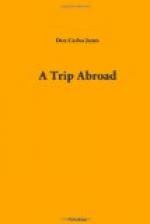The home of Brother and Sister Henry Nelmes, which was my home while I staid in Glasgow, is nicely located. Brother Nelmes and his wife are excellent people, and treated me with much kindness. Glasgow is a large and important city, with many interesting places in it. The Municipal Building with its marble stairs, alabaster balustrade, onyx columns, and other ornamentation, is attractive on the inside, but the exterior impressed me more with the idea of stability than of beauty. The old Cathedral, which I visited twice, is in an excellent state of preservation, although founded in the eleventh century. There is an extensive burial ground adjoining the Cathedral, and one of the prominent monuments is at the grave of John Knox, the reformer. These impressive words, written from memory, were spoken by the Regent at the burial of Knox, and have been carved upon his monument: “Here lieth he who never feared the face of man, who was often threatened with dag and dagger, yet hath ended his days in peace and honor.” Carlyle spoke of him as a man “fearing God, without any other fear.”
One day I visited the birth-place of Robert Burns, at Ayr, a point not far from Glasgow. I not only saw the “lowly thatched cottage,” but a monument to the poet, “Auld Kirk Alloway,” the “brig o’ Doon,” and many interesting articles in the museum. When the street car came to a standstill, I had the old church and cemetery on my right hand, and the monument on my left hand, while a man was standing in the road, ahead of us, blowing a cornet,—and just beyond was the new bridge over the Doon, a short distance below the old one, which is well preserved and profusely decorated with the initials of many visitors. Along the bank of “bonny Doon” lies a little garden, on the corner of which is situated a house where liquor is sold, if I mistake not. It was before this house that I saw the musician already mentioned. As I came up from the old “brig o’ Doon,” I saw and heard a man playing a violin near the monument. When I went down the road toward the new bridge and looked over into the garden, I saw a couple of persons executing a cake-walk, and an old man with one leg off was in the cemetery that surrounds the ruined church, reciting selections from Burns. Such is the picture I beheld when I visited this Ayrshire monument, raised in memory of the sympathetic but unfortunate Scottish poet, whose “spark o’ nature’s fire” has touched so many hearts that his birth-place has more visitors per annum than Shakespeare’s has.
On the following day I had a pleasant boat-ride up Loch (Lake) Long, followed by a merry coach-ride across to the “bonny, bonny banks of Loch Lomond,” which is celebrated in song and story. It is twenty-two miles in length and from three-quarters of a mile to five miles wide, and is called the “Queen of Scottish lakes.” Ben Lomond, a mountain rising to a height of more than three thousand feet, stands on the shore, and it is said that Robert Bruce, the hero of Bannockburn, once hid himself in a cave in this mountain. A pleasant boat-ride down the lake brought me back to Glasgow in time to attend a meeting of the brethren in Coplaw Street that night.




